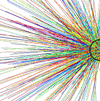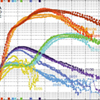
2013 THEMIS SCIENCE NUGGETS
SUMMARIES OF THEMIS RESEARCH
| <<View 2012 THEMIS Nuggets | Return to main page | View 2014 THEMIS Nuggets >> |
 Larry Lyons, November 2013
Larry Lyons, November 2013Westward Traveling Surges: Sliding Along Boundary Arcs and Distinction from Onset Arc Brightening
The westward traveling surge is an interesting and, based on the intense auroral emissions, energetically important aspect of many substorm expansions. Read more.
 Jiang Liu, October 2013
Jiang Liu, October 2013On the role of pressure perturbations around dipolarizing flux bundles
Statistical study shows that a dipolarizaing flux bundle builds up thermal pressure that requires field-aligned currents similar to the substorm current wedge. Read more.
 Martin Archer, September 2013
Martin Archer, September 2013Magnetospheric "magic" frequencies as magnetopause surface eigenmodes
The persistent so-called "magic" magnetospheric frequencies are thought to be either directly driven by monochromatic solar wind pressure fluctuations or resonantly excited global or magnetopause eigenmodes. A statistical study of the magnetospheric response to broadband jets in the magnetosheath, using THEMIS in conjunction with GOES, shows that the observed discrete "magic" frequencies are most likely due to standing surface waves of the magnetopause. Read more.
 C.C. Chaston, August 2013
C.C. Chaston, August 2013Ion heating by broadband electromagnetic waves in the magnetosheath and across the magnetopause
Using THEMIS observations through the Earth's magnetosheath and across the magnetopause, we explore the role that fluctuations in electric and magnetic fields play in modifying the properties of magnetosheath plasmas. Read more.
 T.K.M. Nakamura, August 2013
T.K.M. Nakamura, August 2013Three-dimensional dynamics of vortex-induced reconnection and comparison with THEMIS observations
Three-dimensional fully kinetic simulations demonstrate the formation of magnetic flux ropes along the perimeter of Kelvin-Helmholtz (KH) vortices, and similar flux rope structures have recently been observed by THEMIS. Read more.
 Anton Artemyev, May 2013
Anton Artemyev, May 2013THEMIS measurements of electron energization in the magnetotail
Simultaneous observations of four THEMIS spacecraft distributed along the magnetotail have revealed the dominance of the adiabatic mechanisms for electron energization. Read more.
 Qianli Ma, March 2013
Qianli Ma, March 2013Global distribution of equatorial magnetosonic waves observed by THEMIS
We investigate the wave magnetic field data from THEMIS spacecraft to perform a statistical study of equatorial magnetosonic (MS) wave properties and spatial distribution, and find that strong amplitudes and high occurrence of MS waves are generally observed near the equator, outside the plasmapause, on the dawnside, and during geomagnetically disturbed periods. Read more.
 Michael Hartinger, March 2013
Michael Hartinger, March 2013The role of transient ion foreshock phenomena in driving Pc5 ULF wave activity
Transient Ion Foreshock Phenomena (TIFP) is an umbrella term that refers to many different phenomena, such as hot flow anomalies and foreshock bubbles, that can generate large dynamic pressure fluctuations in the ion foreshock. In a case study, we show that TIFP drive large amplitude Pc5 waves with low correspondence to the IMF cone angle. Read more.
 Drew L. Turner, February 2013
Drew L. Turner, February 2013First observations of foreshock bubbles upstream of Earth’s bow shock: Characteristics and comparisons to HFAs
The ion foreshock can also be responsible for generating large-scale transient kinetic phenomena, such as hot flow anomalies (HFAs), foreshock cavities, short large-amplitude magnetic structures, and foreshock cavitons. Recently, a new type of transient ion foreshock phenomena was predicted using global hybrid simulations: foreshock bubbles. Read more.
 Drew L. Turner, February 2013
Drew L. Turner, February 2013On the storm-time evolution of relativistic electron phase space density in Earth's outer radiation belt
Using in situ and ground-based data from various spacecraft and ground observatories, we examined various outer radiation belth dynamics in detail, as well as whistler-mode chorus and hiss, ultralow frequency (ULF), and electromagnetic ion cyclotron (EMIC) wave activity, each of which has been identified as important to various source, loss, and transport processes for outer belt electrons. Read more.
 Martin Archer, February 2013
Martin Archer, February 2013Magnetosheath dynamic pressure enhancements: Occurrence and typical properties
THEMIS has enabled the first statistical study into abrupt, strong enhancements (or pulses) in the magnetosheath dynamic pressure revealing their predominant origin at the bow shock under steady almost parallel geometries, suggesting that the foreshock is important in their generation. Read more.
 Please send comments/suggestions to
Emmanuel Masongsong / emasongsong@igpp.ucla.edu
Please send comments/suggestions to
Emmanuel Masongsong / emasongsong@igpp.ucla.edu